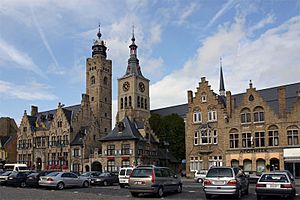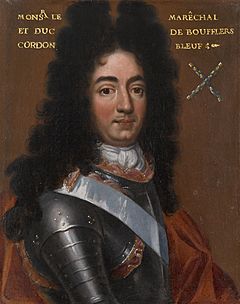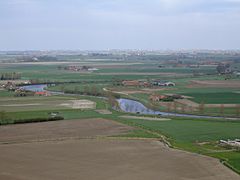Capitulation of Diksmuide facts for kids
Quick facts for kids Siege of Diksmuide July 1695 |
|||||||
|---|---|---|---|---|---|---|---|
| Part of the Nine Years' War | |||||||
 Diksmuide Town Hall and St Nicholas Church |
|||||||
|
|||||||
| Belligerents | |||||||
| Grand Alliance |
|||||||
| Commanders and leaders | |||||||
| Strength | |||||||
| 8,000 | 3,500 - 4,000 estimated | ||||||
| Casualties and losses | |||||||
| Minimal | Minimal Garrison taken prisoner |
||||||
The Capitulation of Diksmuide (also called Dixmuide) was an important event during the Nine Years' War. This big war lasted from 1689 to 1697. Diksmuide was a town in what was then called the Spanish Netherlands, which is now part of Belgium.
In July 1695, a group of countries called the Grand Alliance had about 4,000 soldiers in Diksmuide. A much larger French army attacked them. After only two days, the Allied soldiers surrendered.
By 1695, both sides in the war were running out of money. The main goal for the Grand Alliance was to capture the city of Namur. The French had taken Namur in 1692. The French commander, the Duke of Villeroy, attacked smaller towns like Diksmuide. He hoped this would stop the Allies from getting supplies to their army at Namur.
The quick surrender of Diksmuide was very unusual. The commander, Major General Ellenberg, and other officers faced a military trial. Ellenberg was executed, and some officers were fired. Namur was later captured by the Allies in September. The war officially ended in 1697, but the events at Diksmuide and Namur were some of the last big battles. The French left Diksmuide after the Treaty of Ryswick was signed.
Contents
Why Diksmuide Was Important

The Grand Alliance was a group of countries led by King William III. They had been fighting France for four years. By 1694, they had more soldiers in an area called Flanders (part of modern-day Belgium). They had also taken back towns like Huy and Diksmuide. However, the war was very expensive for everyone.
The 1690s were also a time of very cold and wet weather in Europe. This period is known as the "Little Ice Age." It caused food shortages in many places, including France, Spain, and Scotland. Many people died from hunger.
Most of the fighting in this area happened in the Spanish Netherlands. This region was flat and had many canals and rivers. These waterways were important for moving supplies and soldiers. Namur was especially important because it was located where two rivers, the Sambre and Meuse, met. This made it a key spot for defending the Netherlands from French attacks. Taking Namur back was the main goal for the Allies in 1695.
In April 1695, the French king, Louis XIV, ordered his general, Boufflers, to build defenses. These defenses stretched between the Scheldt and Lys rivers. King William marched his main army towards these defenses in June. But secretly, he sent a large force under Frederick of Prussia to Namur. Once Frederick was in place, William joined him. This split the Allied army. About 58,000 soldiers were at Namur, trying to capture it. Another 102,000 soldiers, led by Prince Vaudémont, were a "field army." Their job was to protect the Namur attackers from the main French army under Villeroy.
To help Vaudémont and keep supplies flowing to Namur, the Allies needed to control river crossings. Diksmuide was one of the most important crossings on the Lys River. Even though it was a small village, it controlled a vital bridge. This made Diksmuide much more important than its size suggested.
The Attack on Diksmuide
Prince Vaudémont's job was to keep his army between the French general Villeroy and Namur. Villeroy tried to trick Vaudémont into moving his army. He attacked other Allied towns like Knokke and Zonnebeke. But Vaudémont did not move.
It was understood that even strong places like Namur would eventually fall if attacked long enough. So, the soldiers defending Diksmuide and Deinze were expected to hold out for as long as possible. This would delay Villeroy.
Diksmuide is located on the Yser River. This river starts in France and flows through Diksmuide before reaching the North Sea. The French had built defenses along the Yser River. This area was so important that it was fought over again in World War I (1914) and World War II (1940). Diksmuide itself was attacked by the Germans in October 1914.
Major-General Ellenberg, an experienced Danish officer, commanded the soldiers at Diksmuide. The Allies had taken the town in 1694. The town's defenses were not in good shape. However, it had a strong group of soldiers: eight battalions of infantry and some cavalry from Lloyd's Dragoons.
Vaudémont's army, which was supposed to protect Namur, had fewer soldiers. Many had been sent to help attack Namur. Villeroy took advantage of this. He gathered more soldiers, giving him about 90,000 men against Vaudémont's 37,000. However, Villeroy's attack on July 14 failed to break the Allied line. Vaudémont was able to retreat in an orderly way, using the bridge over the Lys River at Deinze.
Soon after, a French force led by the Count de Montal arrived at Diksmuide. Ellenberg opened the sluice gates (water control gates). The Allied commander at Nieuwpoort also broke the dykes (walls that hold back water). This flooded the area around Diksmuide. This meant the town could only be attacked from the east. Even though this was the weakest part of the defenses, the situation was not considered hopeless.
The Surrender
On July 26, Montal's army began firing cannons at Diksmuide. After only two days, Ellenberg met with his senior officers. He suggested they surrender the town, saying it was useless to fight more. Eight officers signed the surrender papers. These included Colonel Graham, who commanded a regiment from the elite Scots Brigade. Only Major Robert Duncanson refused to sign. On July 29, Colonel O'Farrell, who commanded the soldiers at Deinze, also surrendered to a French force without a fight.
During this time, besieging (surrounding and attacking) towns was a very precise skill. People even gambled on how long a siege would last! In 1691, a huge amount of money, £200,000, was supposedly bet on the outcome of the Siege of Limerick. Soldiers were expected to defend a town bravely. But if the attackers made a "practicable breach" (a hole big enough to get through), the defenders could surrender and usually get good terms. People at the time thought Diksmuide should have held out for at least eight days. Its quick surrender was very unusual, especially since Ellenberg started talking to the French first.
The surrender terms meant the soldiers became prisoners. They were not allowed to keep their weapons or walk freely to Allied lines. Some people thought Ellenberg was a good officer but couldn't command on his own. This seems unlikely for an experienced senior officer. At his trial, Ellenberg later said "a panic seized him." He couldn't explain why.
Graham and O'Farrell were experienced officers who had fought in many battles. King William was very angry that neither Diksmuide nor Deinze had "done their duty." William's secretary, Constantijn Huygens, wrote in his diary that Ellenberg might have been bribed by the French.
What Happened Next

Soldiers leaving their units or misbehaving was a common problem back then. This was often because of bad conditions and not getting paid on time. But officers not doing their job was a much bigger problem. Evidence from the military trial suggested Ellenberg and O'Farrell simply made bad decisions. However, some thought it might show that many officers were tired of the war or had low morale.
Usually, prisoners of war were exchanged quickly. But the French refused to return the 6,000 to 7,000 Allied soldiers captured at Diksmuide and Deinze. This was because of a disagreement over the surrender terms. Both sides were short of soldiers by this point in the war. It was common for soldiers to leave one army and join another for a signing-on bonus. This was because these bonuses were paid right away, while regular wages were often late. French officers also got money for each new soldier they recruited.
Some people believe this might have been a reason for the surrender. Nearly 3,000 of the captured soldiers were forced to join French regiments. They were sent to fight in Italy or Catalonia. In return, the Allies did something similar. Even though the French commander at Namur, Boufflers, was allowed to surrender on good terms, he was not released. He was held until the remaining Allied prisoners from Diksmuide were returned in September.
After they were released, Major Duncanson was promoted because he refused to sign the surrender. The other officers were put on trial between October 10 and 25. Sir Henry Belasyse led the trial. O'Farrell, Graham, and the others were either dismissed or punished, but they were quickly put back in their jobs. O'Farrell even became a Major-General later. Ellenberg was sentenced to death by beheading. He was executed in Ghent on November 30.
Images for kids






